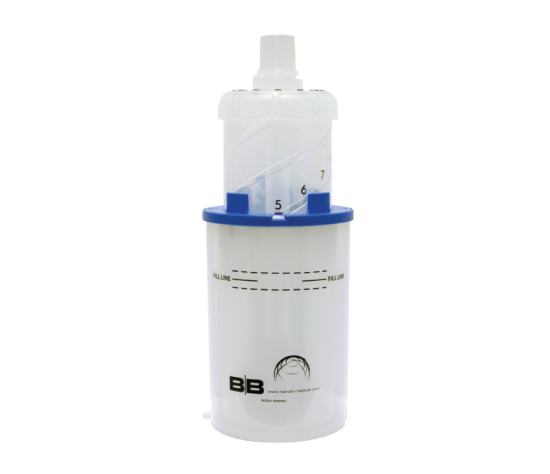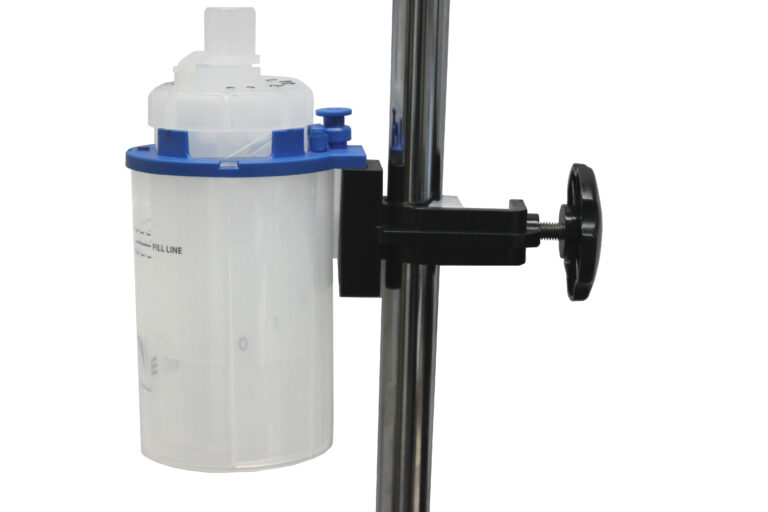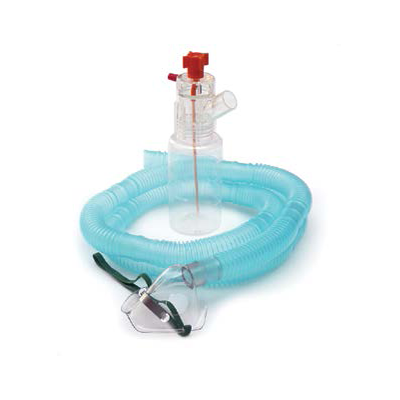Each year, around 12% of babies in the United States are born prematurely, and sadly, about 10% of these infants go on to develop respiratory distress syndrome (RDS), as reported by the National Heart, Lung, and Blood Institute (NHLBI). The risk of RDS significantly increases with earlier birth, with babies born before 29 weeks gestation facing a 60% chance of developing this serious condition.
In contrast, full-term infants have nearly no risk. This underscores the importance of effective respiratory support, such as Bubble CPAP, in helping these vulnerable newborns breathe easier and thrive. Understanding Bubble CPAP is crucial for respiratory care professionals who work with premature infants at risk for RDS.
As healthcare professionals, we’ve seen the impact of non-invasive respiratory support in real time, especially when dealing with respiratory distress and airway management. From the neonatal unit to adult critical care settings, products like Bubble CPAP help patients breathe easier, often avoiding the need for more invasive treatments like mechanical ventilation.
So, is Bubble CPAP just for babies? Definitely not. Whether you’re a neonatal specialist, pediatrician, or respiratory therapist working in critical care, this device plays a pivotal role in improving patient outcomes.
In this blog post, we’ll dive deeper into Bubble CPAP working principle—its benefits, and why it’s indispensable in respiratory care.
Let’s explore Bubble CPAP, the science behind it, and why it has become a go-to solution for respiratory support in both neonatal and adult critical care.
Bubble CPAP working Principle, Benefits, & Indications – A Basic Respiratory Support
What Is Bubble CPAP?
A noninvasive respiratory support technique called bubble continuous positive airway pressure (CPAP) treats newborns experiencing respiratory distress. It works by continuously applying pressure that keeps alveoli from derecruiting, increasing the lungs’ functional residual capacity and reducing the effort required to breathe. Numerous neonatal respiratory disorders can be treated using CPAP.
Why do neonates need respiratory support?
There were 143 newborns in all, with a mean birth weight of 2,770±1,800 g and a mean gestational age of 36±2.7 weeks. bCPAP served as the main neonatal care. The newborn’s temporary tachypnea was the most frequent underlying cause of respiratory distress (42%), followed by a lengthy respiratory transition (34%).
Only nine newborns failed bCPAP, indicating a 93.7 percent therapeutic success rate. Physical face injuries were the most frequent adverse impact.
Bubble CPAP vs CPAP: What’s the Difference?
Both standard CPAP and bubble CPAP are essential for respiratory assistance, especially for newborns. While regular CPAP offers broader applications with precise pressure control, bubble CPAP stands out for its ease of use and effectiveness in particular situations.
Here’s a quick breakdown of both CPAPS in terms of action mechanisms and benefits;
Mechanism of Action:
Bubble CPAP – It works by using a circuit in which the expiratory leg is immersed in water to supply humidified gas. The depth of submersion determines the pressure applied to the patient; as gas bubbles rise through the water, oscillations are produced.
Because of the low-amplitude, high-frequency oscillations it produces, this leads to a changing pressure instead of a continuous one, which can improve gas exchange and lung recruitment.
Conventional CPAP: Traditional CPAP keeps the pressure constant during the breathing cycle and is usually administered by mechanical ventilators or other electrical devices. It delivers air at a preset pressure level via a variety of interfaces, including masks and nasal prongs.
Applications
Bubble CPAP: Mostly used for babies suffering NICU (RDS) respiratory distress syndrome syndromes. Its price and user-friendliness make it particularly attractive in settings with limited resources. It helps prevent bronchopulmonary dysplasia (BPD) and improve overall respiratory function in preterm infants145.
CPAP – Traditional CPAP is used to treat a range of respiratory problems in both adults and children. It is commonly used in both the acute and recovery stages of respiratory distress, despite the possibility that it requires more costly and advanced equipment.
Benefits
Bubble CPAP:
- Simplicity and usability.
- Reduced chance of side effects like BPD in contrast to mechanical ventilation.
- Provide advantageous oscillations that could enhance the matching between ventilation and perfusion.
Traditional CPAP:
- More accurate regulation of airway pressures.
- Appropriate for patients other than newborns.
- For difficult cases, it can be incorporated into all-inclusive ventilatory support systems.
Bubble CPAP Working Principle
For newborns, bubble CPAP (b-CPAP) is a simple yet efficient respiratory support method, especially in critical care environments. This is how it operates:
Gas Delivery – The inspiratory limb of the breathing circuit provides the baby with heated, humidified air or oxygen.
Pressure Creation – A seal is formed when the expiratory limb is submerged in water. The gas bubbles rise through the water as the baby exhales, causing oscillations that produce positive pressure.
Oscillating Pressure – This fluctuating pressure helps to keep the baby’s airways open and enhances lung function.
Lung Expansion – b-CPAP widens the alveoli by maintaining a constant positive pressure in the lungs, which promotes gas exchange and reduces the effort needed to breathe.
The most popular treatment for premature babies with respiratory problems is bubble CPAP neonatal care. By avoiding the need for mechanical ventilation, it lowers the risk of volume trauma and bio-trauma. For some conditions, such as respiratory distress syndrome and apnea of prematurity, bubble CPAP is advised.
All things considered, b-CPAP provides a safe and efficient means of facilitating breathing, fostering lung development, and reducing complications in neonatal critical care for premature infants.
Bubble CPAP Indications
There are many clinical uses for bubble CPAP, particularly for patients who need non-invasive respiratory support. The following are some of the most typical Bubble CPAP indications:
- Neonatal Respiratory Distress Syndrome (RDS):
Premature babies often have RDS due to their poor lung development. Bubble CPAP provides the pressure needed to keep their lungs inflated and prevent further problems.
- Obstructive Sleep Apnea (OSA):
For people with OSA who require continuous airway pressure, bubble CPAP offers an alternative to traditional CPAP equipment.
- Acute Respiratory Distress Syndrome (ARDS):
Bubble CPAP reduces the requirement for invasive ventilation in ARDS patients.
- Hypoxemia and Apnea:
Bubble CPAP can help increase blood oxygen levels in both babies and adults by maintaining open airways and expanded lungs.
Bubble CPAP Age Limit: Is It Just for Babies?
Bubble CPAP is not just for babies, however it is especially well-known for usage in neonatal care. From newborns to adults, the gadget is adaptable and suitable for a broad age range. For patients of all ages who need non-invasive respiratory support, Bubble CPAP is really used in a lot of hospitals and critical care units.
Nevertheless, it’s important to remember that different age groups can need different settings or configurations to guarantee appropriate use. For example, because newborns’ airways are smaller and more delicate, pressure settings are usually lower in neonatal care.
The severity of the ailment being treated may determine the amount of pressure required to maintain proper breathing in adults.
Why B&B Medical Technologies Trusts Bubble CPAP?
Our goal at B&B Medical Technologies has always been to deliver dependable, clinically validated respiratory devices that satisfy the strictest requirements for performance and safety. Our Bubble CPAP products, including the B&B BubblerTM, are made to provide reliable and efficient respiratory support in critical care settings for adults and neonates.
To make sure they perform properly in real medical situations, our products go through a rigorous clinical testing process. Because of its proven safety and efficacy in critical care and neonatal care settings, bubble CPAP is one of the most trusted medical devices in hospitals across the globe.
The Lifesaving Impact of Bubble CPAP in Critical Care
We are here to help you find a dependable, clinically validated Bubble CPAP machine that can satisfy the requirements of your critical care patients. B&B Medical Technologies is a reliable supplier of products designed to ensure patient safety and comfort.
Bubble CPAP has revolutionized respiratory support for both adults and neonates as a noninvasive and effective treatment for severe respiratory disorders. Whether treating preterm newborns with respiratory distress syndrome or adults with acute respiratory failure, this device is crucial for enhancing patient outcomes and preventing the need for invasive treatments. Around the world, hospitals and healthcare providers now choose our B&B BubblerTM.
Our commitment to quality, safety, and patient care drives us to continuously develop innovative solutions that support better health outcomes.
Let’s explore!


